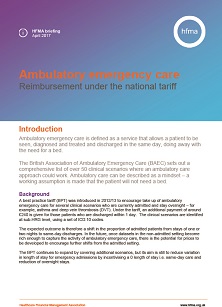Feature / Walk, don’t run
Ambulatory emergency care is defined as a service that allows a patient to be seen, diagnosed, treated and discharged in the same day. The route into such a service is either via the emergency department or direct referral from GPs and the aim is to avoid hospital admissions and overnight stays where it is clinically appropriate.

An emergency admission for an ambulatory care sensitive condition is seen as a sign of poor overall quality of care, even if the episode itself is managed well. In these cases, an ambulatory response is better for patients, can ease pressure on emergency departments and reduce demand for inpatient beds, either cutting costs or helping achieve access targets.
In 2015, NHS England’s publication – Safer, faster, better: good practice in delivering urgent and emergency care – identified ambulatory emergency care (AEC) as a key component of a well-resourced system. It called on acute sites to ‘consider establishing an AEC facility that is resourced to offer emergency care to patients in a non-bedded setting’.
The British Association of Ambulatory Emergency Care >
now lists more than 50 clinical scenarios where an ambulatory care approach could work. A best practice tariff was introduced in 2012/13 to encourage take-up of this approach for a range of clinical scenarios, including asthma and deep vein thrombosis.

The best practice tariff (BPT) sets a higher rate for emergency admissions that have a zero day length of stay – typically £240 higher than the non-best practice tariff rate. This reverses the old approach where the non-elective tariff was reduced for short stays – which provided a perverse incentive not to increase rates of ambulatory care.
There are now 26 clinical scenarios covered by the BPT. Although tariff guidance allows for flexibility in operation, a briefing published by the HFMA earlier this year highlights that there are problems with its operation.
Issues raised in the briefing include:
- An organisation doesn’t need an ambulatory care unit to get the best practice payment
- The tariff doesn’t capture patients treated in an ambulatory manner, but diagnosed with something outside of the clinical scenarios covered
- An emergency admission is needed to obtain the BPT, even though the overall aim is to avoid admissions
- Subsequent attendances – relatively standard in ambulatory care units – are not reflected in the price paid.
A survey to inform the briefing, run by the association’s National Payment Systems Group, found that respondents were equally split between using the national BPT price and agreeing a local price. But there were clear differences in how first attendances were recorded including:
- Non-elective emergency admissions
- Mixture of A&E attendance and emergency admission
- Outpatient first appointment
- Outpatient follow-up appointment.
One organisation said that from April this year, these attendances were now being recorded as a ward attender, rather than a non-elective emergency admission. In addition, just over two thirds of the respondents’ trusts recorded a second visit as an outpatient follow-up.
Respondents said changes were needed to make the BPT work properly. They were keen for greater clarity over recording and collecting data, with a change to the Secondary Uses Service to introduce a third category separate from outpatient or admitted patient care.
The lack of robust data has led to some local approaches on payment. In one case, the commissioner had offered to pay the top A&E tariff to cover both any A&E attendance and ambulatory care. However the trust had felt that A&E triage and care given by the ambulatory unit should be treated separately – leading to the agreement of a block contract.
The introduction of a new emergency care data set from October this year should help by better describing what happens to patients attending accident and emergency departments, minor injury units, urgent care and walk-in centres.
Ambulatory emergency care is not within the scope of the new data set, but the greater granularity of the data – covering condition/injury, triage time, time seen, diagnosis and procedures undertaken – should help improve understanding of patient pathways.
Tariff guidance for this year and next states that nationally mandated prices could be developed to encourage further shifts from the admitted care setting ‘once data sets become rich enough to capture the activity of ambulatory emergency care’.
Models of care
This begs the question: how does the developing approach to ambulatory care – through the best practice tariff and potential future national tariffs – fit with ongoing work on new models of care supported by capitation-based budgets?
New models of care are already being implemented in some areas to provide different pathways for some groups of patients such as the frail elderly and those with chronic conditions. The basic purpose of a capitation budget is to make providers accountable for the outcomes they deliver, but give them flexibility in how they design pathways to deliver those outcomes. The idea is that this would incentivise many of the same responses targeted by the ambulatory care BPT.
Both would look to minimise unnecessary emergency admissions to better serve patients and reduce overall system costs. The capitation budget approach arguably gives providers greater flexibility and encourages a more system-wide approach, with the aim of avoiding emergency presentations altogether.
However the ambulatory care BPT may provide more direct incentives to pursue a specific and evidenced best practice response.
Lee Outhwaite (pictured), finance director at
Chesterfield Royal Hospital NHS FT and chair of the HFMA National Payment Systems Group, says the issues raised by possible moves towards a more mandated tariff for ambulatory care raise questions about the most appropriate way to incentivise system transformation.

‘Providers and commissioners want to provide services that best meet the needs of patients in the most cost-effective way. But service change is complex. There are examples where existing national tariff approaches act as a barrier to change – this is widely recognised. Local flexibility in price setting is one response, but this leaves local bodies needing to have detailed negotiations about how to manage risk and deliver more sustainable services.
‘There are clear tensions in a local versus national price setting approach and with broader capitation approaches,’ he argues. A national price may take no account of the impact of outreach services that aim to reduce emergency episodes. A provider that’s invested in community outreach for chronic illness patients may have less activity coming through A&E and ambulatory care. In this case, the provider wouldn’t benefit from an enhanced BPT to the same extent as a provider that was less proactive in terms of outreach.
Any investment in such outreach services would need to be separately recognised by commissioners if providers weren’t to be disadvantaged by taking a more holistic view.
Long term, capitation budgets may be the way forward – leaving the provider to make changes to different parts of the pathway, with the commissioner focusing solely on outcomes.
Mr Outhwaite says there may still be a role for episodic tariffs – ambulatory care and other components within a pathway – as part of a transition path. ‘Transformation is far from straightforward. Moving to revised pathways with significant changes in services may not be possible in all areas, and the potential risk in making these moves without payment systems that track activity levels may be significant.
‘Individual tariffs, priced locally or nationally, may help systems take manageable steps towards revised pathways – and learn more about the impact of those changes – as part of a move towards capitated payment approaches, where appropriate.’
This calls for robust tariffs underpinned by robust data collected consistently, particularly if the aim is to instigate this nationally. ‘The future is likely to involve using a mix of payment models. We need to continue to feed back on the operation (good or otherwise) of payment approaches. And we need to develop a better understanding of the role that payment systems can play in system transformation.’
Related content
We are excited to bring you a fun packed Eastern Branch Conference in 2025 over three days.
This event is for those that will benefit from an overview of costing in the NHS or those new to costing and will cover why we cost and the processes.